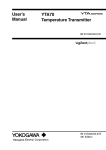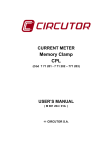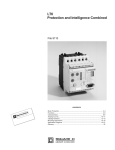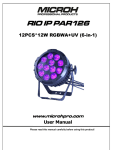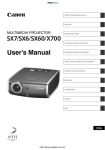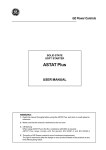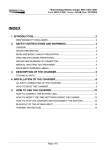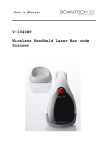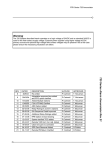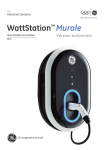Download ASTAT-SD - Gepowercontrols.com
Transcript
GE Power Controls STATIC SOFT STARTER ASTAT-SD USER MANUAL REMARKS : 1. Read this manual throughly before using the ASTAT-SD, and store in a safe place for reference. 2. Make sure that this manual is delivered to the end user 3. CE MARKING When using ASTAT-SD in the EU, compliance with EMC is required. ASTAT-SD is according with the generic EN 50081-2 and EN 50082-2 Index Section 1. Types and powers ........................................................................................................ 1-1 1-2 1-1 IEC ratings ........................................................................................................................ UL ratings .......................................................................................................................... 1-1 1-1 Section 2. Technical specifications .............................................................................................. 2-1 2-1 2-2 2-3 General specifications ....................................................................................................... Operating modes ............................................................................................................... Recommended diagrams .................................................................................................. 2-1 2-2 2-3 Section 3. Start-up. ........................................................................................................................ 3-1 3-1 3-2 3-3 3-4 3-5 3-6 3-7 Equipment installation ....................................................................................................... Dimensions ....................................................................................................................... ASTAT-SD total losses at 100% rated current .................................................................... Fuses and isolation contactor selection guide ................................................................... Control panel description ................................................................................................... Start-up ............................................................................................................................. Error detection ................................................................................................................... ii 3-1 3-2 3-2 3-2 3-3 3-4 3-5 ASTAT-SD . Static soft starters 1. Types and powers 1-1. IEC Ratings Current rating Max. starting current Standard duty (300%, 30 sec.) 220V / 380V / 440V 480V / 240V 415V 500V Heavy duty (450%, 30 sec.) 220V / 380V / 440V 480V / 240V 415V 500V Degree of protection TYPE (1) Cooled A A kW HP kW HP kW HP kW HP kW HP kW HP kW HP kW HP 5 25 1,1 1,5 2,2 3 2,2 3 3 4 1,1 1,5 2,2 3 2,2 3 3 4 IP-20 QS o BNA Natural 9 45 2,2 3 4 5,5 4 5,5 5,5 7,5 2,2 3 4 5,5 4 5,5 5,5 7,5 IP-20 QS o DNA Natural 12 60 3 4 5,5 7,5 6,3 7,5 7,5 10 3 4 5,5 7,5 6,3 7,5 7,5 10 IP-20 QS o FNA Natural 16 80 4 5,5 7,5 10 7,5 10 10 13,5 3,7 5 6,3 7,5 7,5 10 10 13,5 IP-20 QS o GNA Natural 22 110 5,5 7,5 10 13,5 11 15 13 18 5,5 7,5 10 13,5 11 15 13 18 IP-20 QS o HNA Natural 34 170 7,5 10 15 20 18,5 25 20 25 7,5 10 15 20 17 20 20 25 IP-00 QS o INA Natural Degree of protection TYPES (1) Cooled 1-2. UL Ratings Current Max. rating starting current Standard duty (300%, 30 sec.) 200V 230V 460V Heavy duty (450%, 30 sec.) 200V 230V 460V A A HP HP HP HP HP HP 5 25 1 1 3 1 1 3 IP-20 QS o BNA Natural 9 45 2 2 5 2 2 5 IP-20 QS o DNA Natural 12 60 3 3 7,5 3 3 7,5 IP-20 QS o FNA Natural 16 80 3 5 10 3 5 10 IP-20 QS o GNA Natural 22 110 5 7,5 15 5 7,5 15 IP-20 QS o HNA Natural 34 170 10 10 25 7,5 7,5 20 IP-00 QS o INA Natural (1) Replace o by one of the following numbers, according line voltage : 1 = 200 - 440 V 2 = 460 - 500 V 1-1 2. Technical specifications 2-1. General specifications Control Specifications Control system Digital system with microcontroller. Starting ramp with progressive increase in voltage and current limitation Initial voltage (pedestal) % 40 - 90 Un Starting torque % 15 - 80 Mdirect start Kick start % 90 Un (80% Mdirect start), 400ms Current limitation Acceleration ramp time Inputs / Outputs Protections s 0,5 to 60 Energy savings Output voltage reduction according to power factor Override Fixed output voltage permanently equal to supply voltage Deceleration time by ramp Operation 2 to 5 x In s max. 2 x t acceleration ramp (as per energy savings state) External control Start - Stop Acceleration phase Adjustable time Permanent phase Energy savings / override choice Stop phase Power cut-off / ramp choice Inputs 2 optical couplings for Run / Stop commands Outputs 1 relay for Run / End of ramp (1NO) - Selectable Current limit Adjustable from 2In to 5In Loss on input phase s Trip at 3 Thyristor short circuit ms Trip at 200 Loss on output phase s Trip at 3 Supply frequency error Hz If f < 48 ór f > 62, will not start Error (CPU) ms 60 Environmental Temperature ºC 0 to +55 (1) conditions Relative humidity % 95 without condensation Max. altitude m 3000 (2) Mounting positions Vertical Description of 1L1, 3L2, 5L3 Power supply inputs (max. 440 or 500 V, according Types) +10%, -15% terminals 2T1, 4T2, 6T3 Outputs to motor A1 / A2 , B1 / B2 Command supply inputs (110/120 - 220/240V AC) +10%, -15% 11, 14 Run/End of ramp internal relay output (1NO) 1, 57 Run command input 2, 57 Stop command input 3, 4 For future use Output contact Max. usage voltage Vac 380 specs. Thermal current Ith A 8 AC-15 V/A 220 / 3 - 380 / 1 DC-15 V/A max. 30 /3.5 Usage specifications (1) Derate output current by 1,5% / ºC above 45ºC 2-1 (2) Derate output current by 1% / 100m above 1000 meters 2. Technical specifications 2-2. General specifications Operating modes Initial ramp 1 5 main frequency cycles Initial voltage (pedestal) 1a 40 to 90% Un (adjustable) Kick start 2 90% Un (choice) Acceleration ramp (tramp) 3 0.5 to 60s (adjustable) 3a Fast increase of output voltage when the motor reaches rated speed Current limit 4 2 to 5 In Permanent state Choice 5 Nominal voltage (Override) 5a Nominal current 6 Energy savings 7 Motor power cut-off (stopped by inertia) 8 Deceleration ramp. Max. time 2 x tramp 8a Evolution of current in deceleration ramp mode Brake Choice Starting by current limitation Starting by voltage ramp Override Override t t Energy savings Energy savings t t 2-2 2. Technical specifications 2-3. Recommended diagrams Contacts with pulse function Permanent contact control voltage 110/120V AC Start / Stop control voltage 110/120V AC F1 Start Stop FT1 F1 FT1 control voltage 220/240V AC control voltage 220/240V AC (1) (1) ASTAT SD ASTAT SD FT1 (2) FT1 (2) Pulse function with line contactor Permanent contact with line contactor control voltage 110/120V AC Control voltage Start / Stop control voltage 110/120V AC F1 Start Control voltage Stop FT1 FT1 DC1 control voltage 220/240V AC DC1 control voltage 220/240V AC (*) ASTAT SD F1 (*) (1) ASTAT SD FT1 (2) (1) FT1 (2) (*) RUN function enabled (*) RUN function enabled (2) Use thermal relay if required by local rules, selecting it according to motor current (1) These contacts allow for direct action on contactors up to type CL10A at 220V AC. See usage characteristics for determining the need for an auxiliary relay 2-3 3. Start-up 3-1. Equipment installation CAUTION! DISCONNECT POWER BEFORE INSTALLING OR SERVICING ONLY SPECIALIZED PERSONNEL SHOULD INSTALL THE EQUIPMENT AND ONLY AFTER HAVING READ THIS USER'S GUIDE. THE USER ITSELF IS RESPONSIBLE FOR ANY PHYSICAL INJURY OR MATERIAL DAMAGE RESULTING FROM MISHANDLING THE EQUIPMENT. IF YOU HAVE ANY DOUBTS ABOUT ANY PROCEDURE, PLEASE CONTACT YOUR DEALER. When installing equipment, keep the following points in mind - The equipment should be installed vertically and hang over a platform or bars. The vertical position is essential for proper cool air circulation - Equipment should be well ventilated, at least keeping clearances as indicated in the following illustration. - Do not install equipment in environments containing explosive or flammable gases, or near important heat sources - When equipment is to be mounted on a platform subject to strong vibrations, there should be an elastic base to protect the equipment. - Do not install capacitors to correct the power factor between equipment output and motor - Signal wiring should be no longer than 5m, and should be separate from power wires (line, motor, command relays, etc.) by at least 10cm, and if they cross, they should do so at a 90º angle - Relays and contactors located in the same housing as the equipment should have an RC suppressor parallel to the coil (or a reverse diode, if controled by DC). 3-1 3. Start-up 3-2. Dimensions 170 115,5 140 92 92 M4 40 128,5 200 118 A 118 80 128,5 M4 14,2 Ø 6 Ø 7 120 160 14,2 50 155 170 TYPE A QS _ B - N A QS _ D - N A QS _ F - N A QS _ G - N A 150 150 180 180 TYPE A QS _ H - N A QS _ I - N A 200 250 3-3. ASTAT-SD total losses at 100% rated current TYPE Power losses at 100% rated current W Control circuit losses W Total losses Power & Control W QS _ B - N A 15 2 17 QS _ D - N A 29 2 31 QS _ F - N A 35 2 37 QS _ G - N A 47 2 49 QS _ H - N A 73 2 75 QS _ I - N A 84 2 86 3-4. Fuses and isolation contactor selection guide TYPE Isolation contactor Fuses aM A Semiconductor fuses Ferraz type (xx = according to design) Semiconductor fuses Bussmann type (typower Silcu 660V ~) QS _ B - N A CL00 12 6,600 CP URD 22-58/32 Size = 00, In = 32A QS _ D - N A CL00 16 6,600 CP URD 22-58/32 Size = 00, In = 32A QS _ F - N A CL01 20 6,600 CP URC 14-51/40 Size = 00, In = 40A QS _ G - N A CL02 25 6,6 URD 30 xx 0063 Size = 00, In = 50A QS _ H - N A CL03 32 6,6 URD 30 xx 0080 Size = 00. In = 80A QS _ I - N A CL04 63 6,6 URD 30 xx 0100 Size = 00, In = 100A 3-2 A 250 105,5 3. Start-up 3-3. Control panel description 3 1 2 Potentiometers 1 ILT / TORQUE - Current limit (2 - 5 Ir) / Starting torque (15 - 80% DOL), according to dip-switch ILT / TORQUE RAMP - Acceleration ramp time (in seconds) (t ramp) Dip-Switches 2 Position Function HD / SD 1 0 - For future use - For future use ILT/ TORQUE 1 0 - Select ILT / TORQUE potentiometer as current limit level - Select ILT / TORQUE potentiometer as initial torque level KICK START 1 - Kick start function ON. When started, equipment generates a 0.9 Un voltage pulse for 400ms duration and later continues with the preselected starting torque and ramp time. - Kick start function OFF. 0 SOFT STOP 1 0 EOR / RUN 1 0 OVERRIDE LED's 1 0 - Soft stop. Upon receiving stop command, equipment stops by decreasing voltage ramp in a time frame that depends upon the energy savings state selected by stop command (max. 2 x tramp). - No soft stop. Equipment stops by power cut-off by receiving stop command. - Select internal relay (terminals 11-14) as Up to speed relay: contact 11-14 closes when the starting ramp voltage reaches end of ramp - Select internal relay (terminals 11-14) as RUN relay: contact 11-14 closes when the RUN order is given to the unit, and opens either the STOP order is given or an error is found - Override function ON. There is not energy saving - Override function OFF. There is energy saving 3 3-3 3. Start-up 3-4. Start-up - Make sure equipment wiring corresponds to one of the recommended routing diagrams or equivalent - Make sure the control wiring corresponds to the control voltage used. - Set starting parameters according to your application: Voltage ramp or current limit Acceleration ramp time Kick start feature - Set braking paramete according to your application: Soft stop / Power cut-off - Set the rest of the parameters as needed: Select relay output (contact 11-14) as RUN or End of Ramp (up to speed) relay - Send run command to equipment and make sure that operation is correct. 3-4 Select full voltage or energy saving at steady state 3. Start-up 3-5. Error detection Symptom or Error Possible Cause Measures to be taken No control voltage Check wire harness and control voltage Defective control PCB,s Change control PCB,s Equipment does not respond to STOP / START controls Defective control PCB,s Change control PCB,s Frequency error (admits 48Hz < f main < 62Hz) No 1L1 phase or frequence is out of range Check 1L1 phase and/or main frequence Phase sequence loss Disturbance in mains supply Check notches or dropouts in power line Defective thyristor Check thyristors No input phases Check 1L1, 3L2 and 5L3 phases Synchronism loss Phase 1L1 lost Check 1L1 phase Phase U, V, W thyristor Shortcircuited thyristor Check thyristor module No output phases Check 2T1, 4T2 and 6T3 phases No input / output phases Check power wire harness for 1L1, 3L2, 5L3, 2T1, 4T2 and 6T3 Defective thyristor or bad wire harness Verify gate and cathode wire harness. Verify thyristors Microcontroller malfuanction Check that IC2 are correctly inserted in its socket LED "0" off No phase U, V, W conduction Internal failure 3-5 GE Power Controls Belgium Portugal Vynckier Nieuwevaart, 51 B-9000 Gent EC - Material Eléctrico Rua 28 de Janeiro, 350 Apartado 1515 P-4401 Vila Nova de Gaia France Spain Power Controls France BP642 Route de Guise F-02322 Saint-Quentin Power Controls Ibérica Marqués de Comillas, 1 E-08225 Terrassa (Barcelona) Germany United Kingdom Deutsche Vynckier Ernst-Weyden-Straße, 7 D-51105 Köln Power Controls UK Units 21 & 22, Admiralty Way Blackwater Industrial Estate Camberley Surrey GU15 3DT Holland Power Controls Nederland Vanadiumweg, 8 NL-3812 PZ Amersfoort Export Italy CGE Compagnia Generale Elettromeccanica Via Tortona, 27 I-20144 Milano Power Controls Export Department Nieuwevaart, 51 B-9000 Gent Belgium














